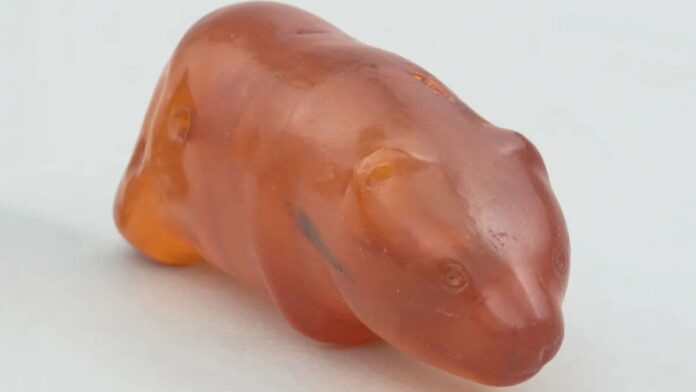A unique carved amber bear was found when workers were delving into the peat in 1887. It is believed that this was worn as a protective charm during the Stone Age, as bears were considered the most powerful and threatening animal of that period. This amber bear was named “Słupcio”, or a “little guy from Słupsk” in Polish. A Polish kindergartner named it after winning the contest of naming this artefact. Now, this carved bear is at the National Museum in Szczecin, placed around 220 kilometres from the original location where it was found.
Discovery of Gummy Bear
Mostly, people were hunters during this period, so their archaeological evidence is rare. However, in the Pomerania region on the southern shore of the Baltic Sea, Stone Age sites with artefacts have been found by archaeologists, such as tools, pottery and weapons, along with the amber-made objects that had washed ashore. After a study of 2023 conducted by archaeologists Daniel Groß and Peter Vang Petersen, where several amber bear statuettes were discovered from the Baltic Sea, it was concluded that the objects are likely to be from a period of Palaeolithic tradition, i.e. 50,000 to 12,000 years ago.
After World War II
During the end of World War II, Słupcio was taken out by Germans from Poland with other ancient artefacts. The amber bear was then placed in the Stralsund Museum until its return to Szczecin in 2009. In Germany, the experts studying it called it “Bernsteinbär” (amber bear) and claimed the carving to be from an ancient period. Since Slupcio was founded more than 100 years ago, there were still arguments when it was made.
Appearance and Use
This carved amber bear is now famous as a local symbol, and its copies are widespread as souvenirs. The statuette is 10.2 centimetres long and 4.2 centimetres tall, weighing 85 grams.
In the statuette’s middle part at the trunk, a hole can be seen that goes all the way through the whole body, used by the ancient hunters to tie a strap across this gummy bear and carry it like a necklace or wrap around the waist or arm.
Ancient Times Perceptions
The amber bears may be further evidence of the Palaeolithic tradition of representing animals in cave paintings and portable objects, and they also show that people shifted their hunting from reindeer on the open tundra to elk and bear in the forest. Due to its properties of being translucent when polished and fragrant on burning, it was perceived as the material of magic, which transformed it into a Stone Age amulet.







